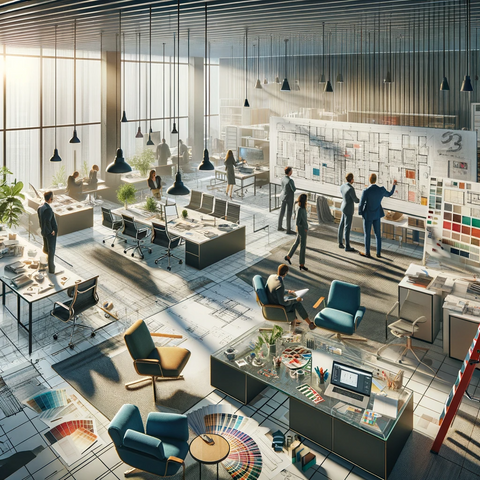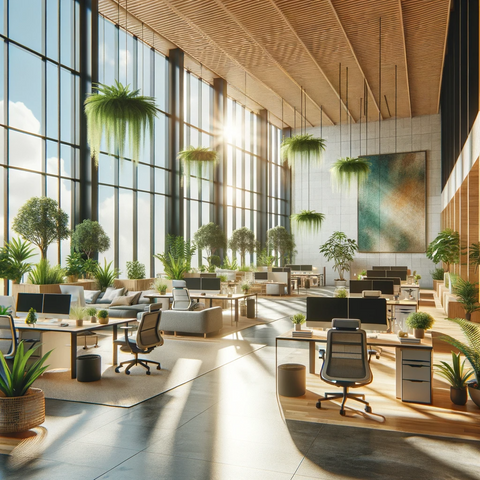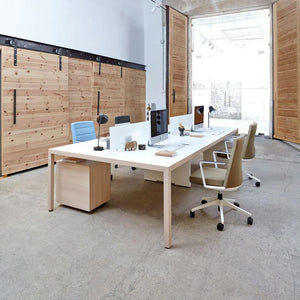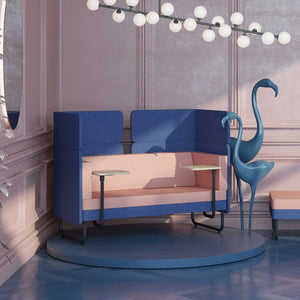
The Ultimate Guide to Office Design: Creating a Productive and Inspiring Workspace
Office design is an often overlooked aspect of creating a productive and inspiring workspace, yet it plays a crucial role in the overall well-being and efficiency of employees. In this ultimate guide, we will explore the importance of office design, the key elements of effective design, incorporating nature into the workspace, the impact of technology, and the significance of designing for employee wellbeing. By the end of this guide, you will have all the tools and knowledge to transform your office into an environment that fosters creativity, productivity, and employee satisfaction.
Understanding the importance of office design
Office design goes beyond aesthetics; it directly impacts the productivity and morale of employees. A well-designed office can motivate employees, enhance their focus, and improve collaboration between teams. Research has shown that a thoughtfully designed workspace can increase productivity by up to 20%, which can have a significant impact on the success of a business.
When considering office design, it is important to take into account the specific needs and preferences of the employees. Each individual may have different work styles and requirements, and a well-designed office should cater to these diverse needs. For example, some employees may prefer open-plan spaces that promote interaction and collaboration, while others may thrive in quieter, more private areas.

The link between office design and productivity
A well-designed office promotes productivity by optimizing the layout, organization, and flow of the space. Creating designated areas for specific tasks can help employees stay focused and minimize distractions. For instance, having separate areas for meetings, individual work, and collaborative projects can ensure that employees have the right environment for each task.
Furthermore, incorporating natural elements into the office design can have a positive impact on productivity. Research has shown that exposure to natural light can improve mood and energy levels, leading to increased productivity. Integrating windows, skylights, and greenery into the office space can create a more vibrant and refreshing atmosphere, benefiting the well-being of employees.
How office design can inspire creativity
Inspiration is a key driver of innovation and creativity. Office design can have a profound impact on employee creativity by providing spaces that encourage collaboration, brainstorming, and out-of-the-box thinking. Creating breakout areas, collaborative zones, and comfortable meeting spaces can stimulate idea generation and foster a culture of innovation within the organization.
Moreover, incorporating elements of art and design into the office environment can inspire creativity. Displaying artwork, using vibrant colors, and incorporating unique architectural features can create a visually stimulating atmosphere that sparks imagination and encourages innovative thinking.
Additionally, office design can also influence employee well-being, which in turn can enhance creativity. Providing comfortable furniture, ergonomic workstations, and relaxation areas can help reduce stress and promote a positive mindset, allowing employees to think more creatively and come up with innovative solutions.
In conclusion, office design plays a crucial role in shaping the productivity and creativity of employees. By creating a well-designed workspace that caters to the specific needs of individuals and promotes collaboration and inspiration, businesses can unlock the full potential of their workforce and drive innovation.
Key elements of effective office design
When redesigning your office, there are several key elements to consider. These elements can influence the functionality, aesthetics, and overall atmosphere of your workspace.
One important aspect to keep in mind when redesigning your office is the layout. The layout of your office will depend on the nature of your business and the specific needs of your employees. Open-plan layouts promote collaboration and communication, allowing for easy interaction between team members. This can be particularly beneficial for companies that rely heavily on teamwork and brainstorming sessions. On the other hand, closed offices or cubicles provide privacy and focus, making them ideal for tasks that require concentration and minimal distractions. Striking a balance between open and closed spaces can create a harmonious environment that caters to various tasks and preferences.
Another crucial factor to consider is lighting. Lighting plays a significant role in office design, as it affects employees' mood, energy levels, and overall well-being. Maximizing natural light by positioning workstations near windows can not only save on energy costs but also boost productivity and reduce eye strain. Natural light has been proven to have a positive impact on employee satisfaction and overall health. Additionally, incorporating adjustable artificial lighting can allow employees to customize their lighting preferences depending on their tasks and personal comfort. This flexibility ensures that each individual can work in an environment that suits their needs.
When it comes to selecting colours for your office, it is important to strike the right balance. The colours chosen can have a significant impact on employee motivation and productivity. Neutral tones such as whites, grays, and earthy tones promote calmness and focus, creating a serene and peaceful atmosphere. These colours are particularly suitable for tasks that require concentration and attention to detail. On the other hand, vibrant colours such as blues, greens, and yellows can stimulate creativity and energy, making them ideal for brainstorming sessions and creative work. However, it is essential to avoid overly distracting or overwhelming colour schemes that may hinder productivity. Striking a balance between creating an inspiring environment and maintaining a sense of professionalism is key.
While these are just a few key elements to consider when redesigning your office, they can significantly impact the overall functionality and atmosphere of your workspace. By carefully considering the layout, lighting, and colours, you can create an office environment that promotes productivity, collaboration, and employee well-being.
Incorporating nature into your office design
Bringing nature indoors can have numerous benefits for employees and their overall well-being. Biophilic design, which focuses on incorporating natural elements into the workspace, has been proven to reduce stress, improve air quality, and enhance creativity.
Imagine walking into your office and being greeted by a lush green wall, teeming with life. The sight of vibrant, thriving plants instantly lifts your spirits and sets a positive tone for the day ahead. This is the power of biophilic design. By seamlessly blending nature with the built environment, we can create workspaces that not only look visually appealing but also promote a sense of tranquillity and connection with the natural world.

The benefits of biophilic design
Exposure to nature has shown to improve mood, decrease stress levels, and increase productivity. It's no wonder that more and more companies are embracing biophilic design principles in their office spaces. Research has found that employees who work in environments with natural elements report higher job satisfaction and overall well-being.
But the benefits of biophilic design go beyond the individual. By incorporating nature into the office, companies can also reduce absenteeism and improve employee retention. A study conducted by the University of Oregon found that employees in offices with natural elements took fewer sick days and were more likely to stay with their current company.
Furthermore, biophilic design has a positive impact on the environment. By using sustainable materials and incorporating energy-efficient features, companies can reduce their carbon footprint and contribute to a greener future.
Tips for adding greenery to your workspace
Adding greenery to your office doesn't have to be complicated or costly. Start small by introducing low-maintenance plants, such as succulents or peace lilies, to individual workstations or common areas. Not only do these plants require minimal care, but they also have air-purifying properties, improving the overall air quality in the office.
Consider creating designated green spaces within your office. These areas can serve as retreats for employees, allowing them to take a break from their screens and recharge amidst nature. Install comfortable seating, soothing water features, and a variety of plants to create a calming oasis where employees can relax and rejuvenate.
Another innovative way to incorporate nature into your office is by installing living walls. These vertical gardens not only add a touch of greenery but also act as natural air filters, removing toxins and pollutants from the air. Living walls can be customized to fit any space, from small office nooks to expansive atriums, making them a versatile option for any office design.
When planning your office revamp, consider consulting with a biophilic design expert who can help you create a workspace that seamlessly integrates nature into every aspect. From the choice of materials to the layout of the space, every detail can contribute to a more harmonious and productive work environment.
In conclusion, incorporating nature into your office design through biophilic principles can have a profound impact on employee well-being and overall productivity. By creating a workspace that mimics the natural world, companies can foster a sense of calmness, connection, and creativity among their employees. So why wait? Start transforming your office into a green oasis today and reap the benefits of a nature-inspired workspace.
The impact of technology on office design
In today's digital age, technology plays a significant role in office design. It influences the way employees work, collaborate, and interact with their environment. Incorporating technology seamlessly into the workspace is essential for ensuring efficiency and creating a modern office environment.
Designing for the digital age
Integrating technology into office design involves providing easily accessible power outlets, installing smart devices, and implementing a reliable and secure network infrastructure. This enables employees to work efficiently, enhances communication, and streamlines processes.
Balancing technology and comfort in the workspace
While technology is necessary in today's office environment, it should never compromise employee comfort and well-being. Providing ergonomic workstations, adjustable seating, and proper cable management solutions can help employees maintain good posture, reduce musculoskeletal issues, and enhance overall comfort while working with technology.
Office design for employee wellbeing
Creating an office environment that prioritizes employee well-being is crucial for maintaining a happy and healthy workforce. By considering the physical and mental well-being of employees, businesses can foster a positive work culture and increase employee satisfaction.
The importance of ergonomic furniture
Investing in ergonomic furniture is a key component of designing a workspace that promotes employee well-being. Ergonomic chairs, adjustable desks, and proper keyboard and monitor placement can help reduce the risk of musculoskeletal disorders, improve posture, and increase employee comfort and productivity.
Designing spaces for relaxation and breaks
Encouraging employees to take regular breaks and providing spaces for relaxation can significantly contribute to their overall well-being and productivity. Designing breakout areas, quiet zones, or even a dedicated wellness room can give employees a chance to recharge, de-stress, and recharge their creative energies.
In conclusion, office design has a profound impact on employee productivity, creativity, and well-being. By understanding the importance of office design, incorporating key elements, embracing nature, balancing technology, and prioritizing employee well-being, you can create a workspace that inspires and facilitates success. Investing in a well-designed office is investing in the success of your business and the happiness of your employees.


